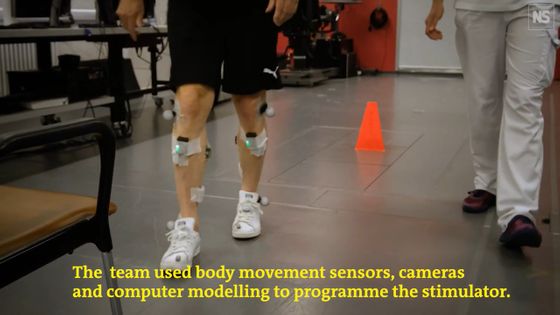A man who can no longer walk due to Parkinson's disease will be able to walk 6 km a day again thanks to an ``implant implanted in his spinal cord''

A spinal cord neuroprosthesis for locomotor deficits due to Parkinson's disease | Nature Medicine
https://www.nature.com/articles/s41591-023-02584-1
Parkinson's patient able to walk 6km without problems after spinal implant | Parkinson's disease | The Guardian
https://www.theguardian.com/society/2023/nov/06/parkinsons-patient-able-to-walk-6km-without-problems-after-spinal-implant
Spine stimulator lets man with severe Parkinson's walk without falling | New Scientist
https://www.newscientist.com/article/2401388-spine-stimulator-lets-man-with-severe-parkinsons-walk-without-falling/
Parkinson's spine stimulator 'allows me to walk 5 kilometres without stopping' - YouTube
Marc, a 63-year-old from Bordeaux, France, was diagnosed with Parkinson's disease more than 20 years ago and developed severe movement disorders, including an impaired sense of balance and foot cramps . Regarding his condition at the time, Marc said, ``I could no longer walk without falling several times a day.There were times, such as when riding an elevator, that my legs would freeze in place.'' Masu.

Parkinson's disease is caused by the loss of neurons that produce the neurotransmitter

In order to restore normal signal transmission from Marc's spinal cord to his leg muscles, a research team led by

Marc's spinal implant targets the area of the spinal cord that activates the muscles in his legs when he walks. First, the research team created an anatomical map of Marc's spinal cord and pinpointed the areas that send signals to move his legs. Next, by embedding electrodes in this area, they were able to send stimulation directly to the spinal cord.

Movement sensors are attached to Marc's legs, and when he starts walking, the spinal implant automatically turns on and begins sending electrical impulses to neurons in the spinal cord. This modifies the signal transmission from the brain to the spinal cord and restores normal movement. Professor Edouard Martin Moreau of Lausanne University Hospital said: 'The patient is never controlled by a machine, it just enhances his ability to walk.'

An analysis of Marc's walking ability after surgery revealed that the spinal implant improved his walking and balance problems, and that his walking ability was more similar to that of a healthy person than to other Parkinson's disease patients. Marc also reported a significant improvement in his quality of life.

Marc commented, ``Now I'm not even afraid of stairs. Every Sunday I go to the lake and walk about 6 km. It's unbelievable.''

'It's very impressive that electrical stimulation of the spinal cord can improve walking problems caused by Parkinson's disease, just as it does for patients with paralysis,' Bloch said. Because more complete clinical trials are needed to demonstrate clinical efficacy, the research team has enrolled six new patients for surgery and will continue to refine and test the method for at least the next five years. is.
Related Posts:







